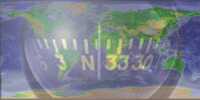 |
home news documentation screenshots reports download contributing bug reporting thanks links disclaimer the kwik-navigator team $id: index.html,v 1.0$ |
the Kwik Navigation Planner |
Kwik-Nav Documentation |
|
Installation NAIPS online flight plan submission Defaults and initialisation Adding Data InstallationKwik-Navigator is a simple stand-alone application and can be installed using the installer. NAIPS online flight plan submissionKwik-Navigator now supports the production of the standard ICAO flight plan forms as well as the functionality to provide an export to Airservices Australia NAIPS system. The NAIPS software can be accessed free of charge from the Airservices website:
https://www.airservicesaustralia.com/naips/
Please note: See https://www.airservicesaustralia.com/naips/Documents/About for more details. Defaults and initialisationUser settings are stored in the knav.ini file which resides in the kwik-nav installation folder. This file can be edited using the view/startup option or using your favorite text editor. The default knav.ini file supplied with the distribution is comprehensively commented and should not present any undue difficulties to configure. A few of the less obvious entries are explained in more detail below: SPAN THRESHOLDThe threshold for when and how the available dib data is displayed, is controlled by the knav.ini file with the [SpanThreshold] entry. The following is the default settings, but they can be changed at will, depending on the users needs. ;----------------------------------------------- ; Define the threshold for switching resolutions ; eg. ; 1000=2 - use 10.00 deg images when mag > 2 ; 0100=4 - use 1.00 deg images when mag > 4 ; 0025=8 - use 0.25 deg (15min) images when mag > 8 ; [SpanThreshold] 1000=2 0100=4 0025=8 For example, if you want the 10 deg data to be avaliable for greater zoom states, the entries could be modified thus: [SpanThreshold] 1000=4 0100=8 0025=12 Adding and installing dataAdding relief data to your kwik-nav installationUSING CD-ROM data* Adding Relief data to a Knav installation: There are two ways to add shaded relief data to you KNav installation: 1) Setting the knav.ini file to point to the relief data on your CD by editing the section [Initze] and entry szShadeDataPath and setting it to the correct path on the CD. For example if your CD rom is mounted as drive F the entry would look as follows: [Initze] szShadeDataPath=f:/KNav/relief/ szBinDataPath=./vector/ 2) Copying the relief data to your KNav installation folder. The relief data needs to be placed in a folder /KNav/relief. For example if your KNav installation is on drive C and your CD rom is mounted as drive F, the following commands will copy the required data: c: cd knav md relief cd relief xcopy f:\knav\relief\*.* /s In this example the entry would look as follows: [Initze] szShadeDataPath=./relief/ szBinDataPath=./vector/ or [Initze] szShadeDataPath=C:/KNav/relief/ szBinDataPath=C:/KNav/vector/ Note: Adding vector data to your kwik-nav installationThe default installation will install a 1: 10 000 000 vector set coastline of the world by default. Adding additional vector sets is similar to adding relief data as explained above. Firstly the data location is specified in the knav.ini file, [Initze] section as szBinDataPath like in the following example. [Initze] szShadeDataPath=f:/KNav/relief/ szBinDataPath=./vector/ Up to 24 vector sets can be active at any one time. They are specified in the sections [StaticVector_1] through to [StaticVector_23]. By default most will be "commented" out with the ";" character. For further detail refer to the comments in the knav.ini file. |